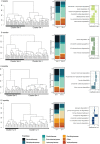Bacteroides abundance drives birth mode dependent infant gut microbiota developmental trajectories
- PMID: 36274732
- PMCID: PMC9583133
- DOI: 10.3389/fmicb.2022.953475
Bacteroides abundance drives birth mode dependent infant gut microbiota developmental trajectories
Abstract
Background and aims: Birth mode and other early life factors affect a newborn's microbial colonization with potential long-term health effects. Individual variations in early life gut microbiota development, especially their effects on the functional repertoire of microbiota, are still poorly characterized. This study aims to provide new insights into the gut microbiome developmental trajectories during the first year of life.
Methods: Our study comprised 78 term infants sampled at 3 weeks, 3 months, 6 months, and 12 months (n = 280 total samples), and their mothers were sampled in late pregnancy (n = 50). Fecal DNA was subjected to shotgun metagenomic sequencing. Infant samples were studied for taxonomic and functional maturation, and maternal microbiota was used as a reference. Hierarchical clustering on taxonomic profiles was used to identify the main microbiota developmental trajectories in the infants, and their associations with perinatal and postnatal factors were assessed.
Results: In line with previous studies, infant microbiota composition showed increased alpha diversity and decreased beta diversity by age, converging toward an adult-like profile. However, we did not observe an increase in functional alpha diversity, which was stable and comparable with the mother samples throughout all the sampling points. Using a de novo clustering approach, two main infant microbiota clusters driven by Bacteroidaceae and Clostridiaceae emerged at each time point. The clusters were associated with birth mode and their functions differed mainly in terms of biosynthetic and carbohydrate degradation pathways, some of which consistently differed between the clusters for all the time points. The longitudinal analysis indicated three main microbiota developmental trajectories, with the majority of the infants retaining their characteristic cluster until 1 year. As many as 40% of vaginally delivered infants were grouped with infants delivered by C-section due to their clear and persistent depletion in Bacteroides. Intrapartum antibiotics, any perinatal or postnatal factors, maternal microbiota composition, or other maternal factors did not explain the depletion in Bacteroides in the subset of vaginally born infants.
Conclusion: Our study provides an enhanced understanding of the compositional and functional early life gut microbiota trajectories, opening avenues for investigating elusive causes that influence non-typical microbiota development.
Keywords: Bacteroides; cesarean section; functional maturation; hierarchical clustering; infant gut microbiota; shotgun metagenomics; vaginal delivery.
Copyright © 2022 Matharu, Ponsero, Dikareva, Korpela, Kolho, de Vos and Salonen.
Conflict of interest statement
The authors declare that the research was conducted in the absence of any commercial or financial relationships that could be construed as a potential conflict of interest.
Figures




References
-
- Aitchison J., Barceló-Vidal C., Martín-Fernández J. A., Pawlowsky-Glahn V. (2000). Logratio Analysis and Compositional Distance. Math. Geol. 32, 271–275. 10.1023/A:1007529726302 - DOI
-
- Aloisio I., Mazzola G., Corvaglia L. T., Tonti G., Faldella G., Biavati B., et al. (2014). Influence of intrapartum antibiotic prophylaxis against group B Streptococcus on the early newborn gut composition and evaluation of the anti-Streptococcus activity of Bifidobacterium strains. Appl. Microbiol. Biotechnol. 98, 6051–6060. 10.1007/s00253-014-5712-9 - DOI - PubMed
LinkOut - more resources
Full Text Sources
Research Materials

